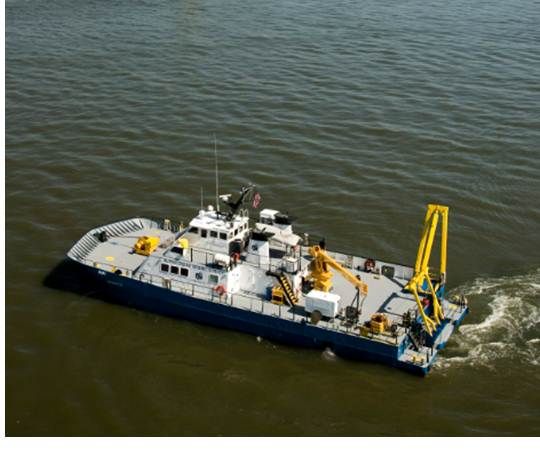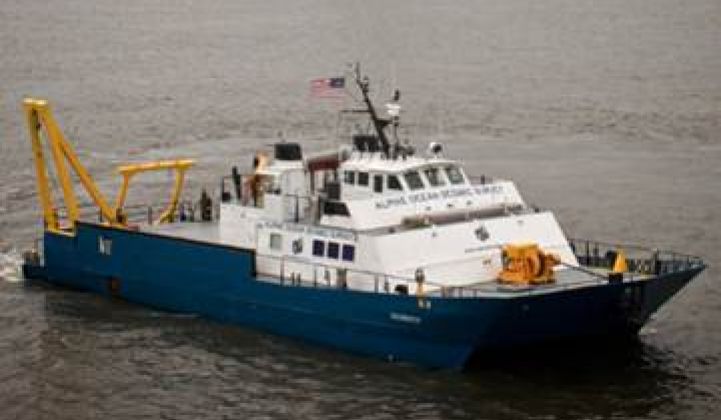Seeing U.S. renewable energy setting to sea, Alpine Ocean Seismic Surveys seized the emerging opportunity.
Alpine has done marine surveying and data collection for the offshore, coastal and freshwater oil and gas and submerged pipeline and cable industries since 1957. “We were looking to go to the next level, said Rob Mecarini, Alpine’s co-owner and Executive Vice President. “One of the industries we were targeting was offshore renewables.”
To grab the opportunity it saw, Alpine partnered with U.K.-based Gardline Marine Services Group, which had been involved with offshore wind and other ocean renewables in Europe for a decade. “It’s the largest privately owned survey company in the world,” Mecarini said, “and one of the biggest companies involved in offshore surveying for renewables in Europe.”
Behind Alpine’s move to ocean renewables, Mecarini said, “there was a personal impulse and an economic impulse.” He explained, “I thought renewables was something I would be proud to be involved in ... [because it seemed] good for my kids and the planet.”
There was also an economic impulse. “It could be the next internet,” Mecarini said. “From a business strategy point of view,” he said of offshore renewables, “we thought it was a real growth industry and we thought we’d be able to bring to the table a lot of things useful to our clients. We have a lot of experience working in this part of the world.”
Alpine has now brought to the table the Shearwater, a purpose-designed, state-of-the-art 110-foot marine surveying research vessel similar to those used by Gardline and other vessel providers in Europe. (Interestingly, we recently profiled Liquid Robotics, a company that wants to launch fleets of robots rigged with sensors and instruments to map activity on the sea.)

Using leased third-party vessels, Alpine did the sea floor surveying for the meteorological tower installed by Fishermen’s Energy in preparation for a wind project off New Jersey’s Atlantic City coast. The survey taught Alpine much about what a dedicated, full-service research vessel needs.
The Shearwater, due to officially launch June 22, has a low-noise hydraulic propulsion system that gives it advanced maneuverability and allows for dynamic positioning. Mecarini called it “a very steerable boat.” The steering system can be operated from a wireless box, allowing the captain to move to where he can best observe and modify his efforts.
The vessel has dedicated labs and office space, redundant generators, a desalination system, sleeps twenty, allows round-the-clock crewing and is capable of operating autonomously at sea for up to fourteen days.

Digital communications and computing within the labs and offices allow research teams to plug-and-play. Networks allow data processing and sharing, facilitating ongoing review of collected and collated data. The comprehensive capabilities allow for simultaneous or sequential surveys.
Running underneath the Shearwater’s hull are cylindrical tubes in which sound equipment used to map the sea floor and monitor the marine environment is pre-fitted and able to be repositioned as the vessel moves and needs change. Multiple echosounders, streamers, magnetometers, gradiometers and sonar scanners serve hydrography and geophysics.
Water sampling, turbidity monitoring, grabbers, high-powered corers and drop-down cameras serve benthic, oceanographic and geotechnical studies. Specifically selected and mounted lifting equipment (a two-ton crane, one- and five-ton A-frames, a five-ton geotechnical winch and other dedicated winches) facilitate data gathering.

The cost for the use of Shearwater’s comprehensive facilities, Mecarini said, will range in very broad numbers from $7,000 to $8,000 for a 12-hour day to $8,000 to $9,500 for 24-hours-per-day operations.
Ultimately, the U.S. ocean energy industries will need a fleet of such vessels to provide services that begin with the mapping of the seabed and end with the decommissioning of out-of-date and damaged equipment. Other services that will be needed include the performance of all environmental studies, including the pre-monitoring of impacts on the ocean’s flora and fauna such as crustaceans, marine mammals and avian life, the transport and erection of turbines and wave, tidal and current energy devices, and the transport of maintenance and emergency crews.
The Shearwater’s maiden undertakings for the U.S. Army Corps of Engineers and the New Jersey Department of Environmental Protection won it praise. Though non-disclosure agreements prevented him from naming names, Mecarini said Alpine is now engaged in talks about other offshore wind and hydrokinetic projects and subsea transmission lines. It was reasonable to assume, he agreed, that Netherlands-based Fugro, which Mecarini said is probably Alpine’s chief competition, is similarly engaged.
From working with Fishermen’s Energy, Mecarini observed firsthand the difference between negotiating the federal permitting process -- as demonstrated by Cape Wind’s just-completed nine-year approvals ordeal -- and the simpler, more streamlined New Jersey state permitting process, through which the Fishermen’s Energy project has almost worked its way.
NIMBY (Not In My Backyard) obstructions are likely to continue, a frustrated Mecarini said, “until the fear goes away when people finally realize you can build a wind farm offshore where you can barely see it in the distance and the sky is not going to fall and their real estate values aren’t going to crash.”
Mecarini was equally frustrated by the federal government’s on-again, off-again renewables policy, which has offshore wind development on idle at present. “It seems like it’s two steps forward and one step back,” he said of efforts to advance development in federal waters, where it must ultimately be built if it is to achieve scale. “There are going to be problems with offshore wind until U.S. energy policy gets straightened out and there are clear long-term goals and policies. As long as we don’t have that policy roadmap and something developers can bank on, there will be problems.”



